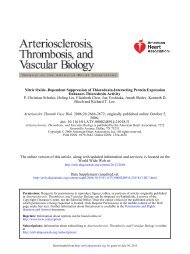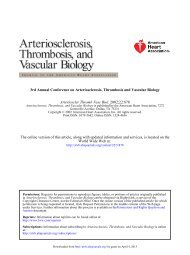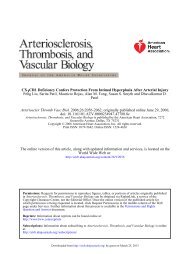1994;14;1751-1760 Arterioscler Thromb Vasc Biol AH Lichtenstein ...
1994;14;1751-1760 Arterioscler Thromb Vasc Biol AH Lichtenstein ...
1994;14;1751-1760 Arterioscler Thromb Vasc Biol AH Lichtenstein ...
- TAGS
- 1994
Create successful ePaper yourself
Turn your PDF publications into a flip-book with our unique Google optimized e-Paper software.
-1 250<br />
O 225<br />
CE<br />
UJ<br />
d 20 °<br />
X<br />
o<br />
_l<br />
5 17!<br />
— 50<br />
_i<br />
O a:<br />
UJ<br />
co<br />
ai<br />
O<br />
o<br />
30<br />
I 8 12 16 20 24<br />
TIME (hours)<br />
1 3 12 19 20 24<br />
TIME (hours)<br />
300<br />
o> 250<br />
LU<br />
n<br />
— 200<br />
UJ<br />
o<br />
g<br />
a:<br />
150<br />
100<br />
<strong>Lichtenstein</strong> et al Low-Fat Diet, Weight Loss, and Plasma Lipids 1757<br />
8 12 16<br />
TIME (hours)<br />
« a 12 19<br />
TIME (hours)<br />
fat or low-fat (| energy) diets were consumed, the<br />
relative change in LDL and LDL apoB concentrations<br />
exceeded that of HDL-C or apoA-I.<br />
When the subjects consumed the reduced-fat diet,<br />
which was consistent with NCEP step 2 guidelines, total<br />
cholesterol, LDL-C, and HDL-C concentrations decreased<br />
relative to the baseline diet. Further reducing<br />
the fat content of the diet from 29% to 15% of calories<br />
was achieved by eliminating most sources of added fat.<br />
In keeping with the design of the study the actual foods<br />
making up the diet were not altered. This resulted in a<br />
large decrease in poryunsaturated fat, a moderate decrease<br />
in monounsaturated fat, and a smaller decrease<br />
in saturated fat in the diet. These changes themselves<br />
may have accounted for the greater decrease in HDL-C<br />
than LDL-C when subjects consumed the low-fat (—><br />
energy) diet. However, at extremely low levels of total<br />
fat in the diet, observations pertaining to the differential<br />
effects of the different individuals or classes of fatty<br />
acids may not be valid.<br />
Decreasing the fat content of the diet and increasing<br />
the carbohydrate content likely resulted in a concomitant<br />
increase in the level of fiber in the diet, 35 - 36 a<br />
variable that was not specifically addressed in the current<br />
study. Independent effects of total and soluble fiber<br />
on plasma lipid levels have been documented. 7173 However,<br />
the primary aim of the present investigation was to<br />
assess the effects of varying the fat content of the diet<br />
with commonly available foods. An alternate approach,<br />
to isolate the independent effects of fat and fiber, would<br />
have necessitated artificially keeping the fiber constant<br />
while altering the fat content of the diet, which would<br />
have answered a different but interesting experimental<br />
question.<br />
The trigfyceride levels remained relatively stable<br />
when the carbohydrate content of the diet was increased<br />
20 24<br />
FIG 2. Line plots of mean postprandial total cholesterol,<br />
non-high-density llpoprotein (HDL) cholesterol, HDL cholesterol,<br />
and triglyceride values after subjects were ted a<br />
baseline (circle), reduced-fat (triangle), low-fat (-> energy)<br />
(square), or low-fat (J. energy) (diamond) diet. See "Methods"<br />
for definitions of diets. *P














